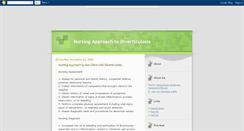Nursing Approach to Diverticulosis
OVERVIEW
NURSINGAPPROACHDIVERTICULOSIS.BLOGSPOT.COM RANKINGS
Date Range
Date Range
Date Range
LINKS TO WEB SITE
Monday, November 28, 2005. The economic implications of this disease are astonishing.
Types of Asthma and Their Clinical Features. Monday, November 21, 2005. Types of Asthma and Their Clinical Features. As presented by Brigette Hales, M. There are three forms of asthma known, for all of which the underlying causes have not been entirely elucidated.
Monday, November 07, 2005. Nursing Approach to the Client with Chest Injuries, Pneumothorax, or Hemothorax. 1 Assess for history of the injury. 3 Assess chest wall for presence of wounds and fractures. 6 Assess vital signs, CVP, ECG, fluid balance. 3 Pain related to injury.
Nursing Approach to Ischemic Heart Disease. Monday, November 07, 2005. Nursing Approach to the Client with Ischemic Heart Disease. 3 If chest discomfort is present at the time of the interview, further collection of data is delayed until pain and dysrhythmias are resolved.
Monday, November 07, 2005. Nursing Approach to the Client with Pulmonary Hypertension. 1 One of the most important nursing interventions is to identify those clients who are at high risk of developing pulmonary hypertension, such as those with COPD, pulmonary emboli, CHF, and mitral valve disease. 2 Obtain history from the client regarding onset and progression of symptoms and existing cardiac or pulmonary disease. Please note this information does not give any.
Tuesday, November 08, 2005. Nursing Care Plan to the Client with Fractures of the Extremities and Extremities Surgery. 4 Assess extremity for presence of open fracture and severe external hemorrhage.
Monday, November 07, 2005. General Nursing Approach to a Client during Postoperative Period. 1 Verify patency of airway. 2 Establish baseline vital signs, breath sounds. 3 Determine level of consciousness. 4 Observe tubes for patency and placement, and drainage for characteristics. 5 Inspect dressing if presents, and change if requires. 6 Determine fluid input and urinary output. 7 Assess for signs of normal wound healing after initial postoperative period.
Tuesday, November 22, 2005. A review of historical data suggest that flu pandemics occur when the virus acquires a new hemagglutinin and or neuraminidas. The incubation period for influenza is 24 to 72 hours. Adults with influenza remain infectious for 3 to 5 days after onset of symptoms, and children may remain infectious for up to a week after onset. Influenza is spread very easily indoors, which is why it is so prevalent in the winter months in northern countries.
WHAT DOES NURSINGAPPROACHDIVERTICULOSIS.BLOGSPOT.COM LOOK LIKE?



NURSINGAPPROACHDIVERTICULOSIS.BLOGSPOT.COM HOST
WEBSITE IMAGE

SERVER OS AND ENCODING
I found that this domain is operating the GSE server.PAGE TITLE
Nursing Approach to DiverticulosisDESCRIPTION
Nursing Approach to Diverticulosis. Tuesday, November 01, 2005. Nursing Approach to the Client with Diverticulosis. 1 Assess for personal and family history, congenital defects, previous abdominal trauma. 2 Collect information of complaints that brought client to the hospital. 3 Obtain history of onset and progression of symptoms. 4 Obtain information of signs of bowel inflammatory process, obstruction, or GI bleeding. 6 Assess diagnostic tests and procedures for abnormal values. 6 Decreased anxiety with.CONTENT
This web page nursingapproachdiverticulosis.blogspot.com states the following, "Tuesday, November 01, 2005." We saw that the webpage said " Nursing Approach to the Client with Diverticulosis." It also said " 1 Assess for personal and family history, congenital defects, previous abdominal trauma. 2 Collect information of complaints that brought client to the hospital. 3 Obtain history of onset and progression of symptoms. 4 Obtain information of signs of bowel inflammatory process, obstruction, or GI bleeding. 6 Assess diagnostic tests and procedures for abnormal values."SEEK SIMILAR DOMAINS
Tuesday, November 01, 2005. Nursing Approach to the Client with Gallbladder and Biliary Tract Disorders. 1 Assess for personal and family history, presence of diabetes mellitus, usage of oral contraception, previous or present liver diseases or pancreatitis . 3 Obtain history of onset and progression of symptoms.
Nursing Approach to Head and Spinal Injury. Monday, November 07, 2005. Nursing Approach to the Client with a Head and Spinal Injury. 1 Assess airway, breathing pattern, and respiratory status. 2 Assess baseline vital signs and circulatory status. 3 Collect information of circumstances of injury. Signs of increased intracranial pressure;. Presence of convulsions; and. Presence or absence sensation and motor activity in any parts of the body.
Nursing Approach to Ischemic Heart Disease. Monday, November 07, 2005. Nursing Approach to the Client with Ischemic Heart Disease. 3 If chest discomfort is present at the time of the interview, further collection of data is delayed until pain and dysrhythmias are resolved.
Nursing Approach to Motoric Bowel Disorders. Tuesday, November 01, 2005. Nursing Approach to the Client with Motoric Bowel Disorders. 1 Assess for personal and family history, congenital defects, previous abdominal trauma, autoimmune and allergic states, medications usage, previous bowel infections or disorders. 2 Collect information of complaints that brought client to the hospital. 3 Obtain history of onset and progression of symptoms. 6 Assess diagnostic tests and procedures for abnormal values.
Nursing Approach to Neoplastic GI tract. Tuesday, November 01, 2005. Nursing Approach to the Client with Neoplastic process of the GI tract. 1 Assess for personal and family history, presence of previous GI damage, age, occupation, presence of other neoplastic changes, diet and nutritional habits, usage of certain medications. 3 Obtain history of onset and progression of symptoms. 4 Obtain information of signs of neoplastic changes in GI system. 5 Pain and restlessness, related to diagnosis of malignant .